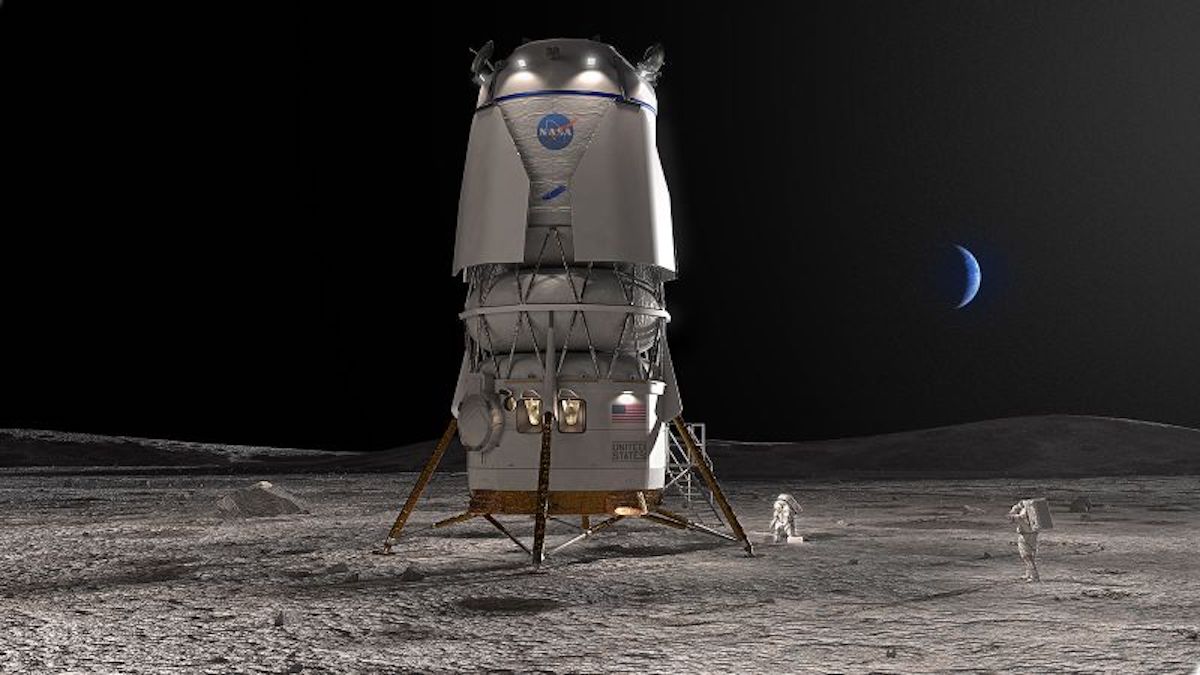This is how a Blue Origin rocket catches fire during launch 2:05
(CNN) -- Blue Origin, the space company founded by Jeff Bezos, will join NASA's moon landing program, competing against Elon Musk's SpaceX to develop spacecraft aimed at transporting astronauts to the surface of the Moon.
NASA announced Friday that Blue Origin will work to prepare its Blue Moon lander concept for a mission dubbed Artemis V, which is scheduled to blast off in 2028. Artemis V would be the third in a series of missions under NASA's lunar program that are expected to take humans to the moon.
Blue Origin will develop its lunar lander alongside partners Lockheed Martin, Draper, Boeing, Astrobotic and Honeybee Robotics.
- Jeff Bezos' ship, named after his mother, will no longer be used to trap Blue Origin rockets
In total, the price tag for Blue Origin's lunar lander development program is likely worth more than $7 billion. The contract is worth about $000.3 billion, according to Jim Free, NASA's associate administrator for exploration systems development.
And "Blue Origin will contribute more than $3.400 billion as part of this effort," John Couluris, the company's vice president of lunar transportation, said during a press conference Friday.
advertising
"We want to establish permanence on the Moon and we want to make sure we have constant access to the Moon," NASA Administrator Bill Nelson added. "So, with that in mind, Blue Origin itself will contribute more than 50% of the total effort to reach not only this mission, but also to ensure permanence."
A radical change for the development of the lunar lander
SpaceX was awarded the first lunar landing contract — worth $2.900 billion — in April 2021, putting the company in place to develop a version of its upcoming Starship spacecraft for NASA's Artemis III mission. It is expected to launch from 2025.
It's unknown whether NASA and SpaceX will meet that deadline. The Starship exploded last month after its inaugural test launch attempt.
What's next for SpaceX after the Starship explosion? 2:51
Blue Origin has fought for a stake in Artemis moon landing contracts — called the Human Landing System — for years. After SpaceX won its 2021 contract, Blue Origin sued the U.S. government, saying NASA unfairly favored SpaceX and arguing that the space agency would be better served if it funded SpaceX and Blue Origin's plans to develop vehicles capable of landing on the moon.
A judge ultimately ruled against Blue Origin, though NASA later pledged to expand the number of companies with lunar landing contracts to two.
NASA said early on that it hoped to have more than one company working to develop lunar landers capable of carrying humans. But after awarding a single-source contract to SpaceX, the space agency repeatedly cited costs as the reason. Congress appropriated NASA about $2 billion less than it requested in fiscal year 000.
But NASA received a small raise for the Human Landing System in fiscal year 2022: $150 million more than it requested for the lunar landing program.
Still, NASA awarded SpaceX another contract option in November, giving the company a path to also provide the lunar lander for the Artemis IV mission, scheduled for 2027. That deal was valued at about $1.150 billion.
Friday's announcement marks a sea change for the program, officially adding a second lunar landing provider to compete with SpaceX on missions beyond Artemis V.
Blue Origin Human Landing System Plans
From the beginning of the Human Landing System program, Blue Origin and SpaceX gave NASA two very different proposals to set foot on the Moon.
While SpaceX plans to use Starship, a gigantic system of rockets and spacecraft designed to work on its own, Blue Origin had a simpler plan to develop a lunar lander, similar to those used for the Apollo missions. Blue Origin's lunar lander would travel as a payload on a separate rocket, while SpaceX's Starship is its own autonomous system.
However, functionally, Blue Moon would assume the same role as SpaceX's Starship part of the spacecraft.
For Artemis III, Starship would launch empty to the Moon. It would rendezvous with NASA's Orion crew capsule, which aims to take astronauts into lunar orbit. After the astronauts transferred the vehicles, Starship would take over the work of landing on the surface of the Moon, allowing the astronauts to explore and then return them to Orion in lunar orbit.
For Artemis IV, Starship would also dock with Gateway, a planned space station intended to orbit the moon.
Both companies will be required to complete exploration missions — or test flights — before they can make such landings.
Blue OriginBlue Origin Jeff BezosJeff BezosNASA
